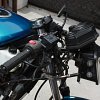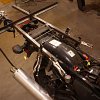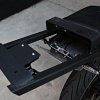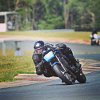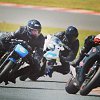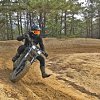Over the last two years, I took some rides with my girl (her name’s Edie, and she’s a dog). I rode to work in the snow. I jousted for position with a big-bucks BMW S 1000 RR at a track day. I rode an AMA enduro in the Pine Barrens of New Jersey.
No big deal. Except that I did it all on the same motorcycle. A bike that cost me about $1,000 to buy and a little more money and time in modifications.
A motorcycle should be a rider’s own personal creation, right? Here’s mine.
The Genesis: A need, not a plan
Winter hits Philadelphia hard. I loved my 1991 Suzuki Bandit GSF400, but its carbureted inline four hated the cold even more than I did, and it was not obligated to show up at RevZilla at 9 a.m., as I was. On days it wouldn’t start, my next commuting option was my mountain bike, but asthma was sucking the joy out of my winter bicycle commute, which pretty much sucked to begin with. Cabbing to work at $20 each way was killing me.
I needed another option.
I spotted a 1997 Kawasaki Ninja 500 for sale. These bikes can often be found for less money used than the smaller 250, which is the quintessential beginner bike. This one was owned by a gent named Frank, who was starry-eyed for a Ninja ZX-10R. Frank was still not old enough to drink, but that clearly wasn’t about to stop him from making poor life decisions.
“Frank!” became the name I would bemoan multiple times while shaking my fist at the sky after making “discoveries” while working on the bike. The headlight was wedged in place with duct tape and newspaper. There were about two strands of a potential 16 wrapped around the ground terminal of the battery. A leaking fork seal pumped fork oil onto my single front brake rotor, making for some serious butt-puckering moments. Lemmy said my bike was a complete piece of shit and I was wasting time and money trying to fix it up. I felt that was debatable and set out to prove him wrong.

Stage one: Getting the Ninja ready to ride
The Ninja 500 was reputedly engineered for a rider about five feet, six inches tall and weighing 140 pounds. I am six feet, three inches tall and weigh 215. The stock handlebar made me feel like a T-Rex. Woodcraft clip-ons dropped the grips by seven inches, but that meant the front fairing assembly had to go. I dug the 1980s look of the rectangular, first-generation EX500 headlight, so I proceeded to modify a first-gen headlight stay to accept the second-gen gauge cluster and lowered the headlight. These modifications took forever, because I was worried about damaging the bike’s electronics and did all of the welding off of the bike. It was a lot of dry fitting and complicated jigging.
The tires on the bike lived through the majority of the Bush administration and it was time for change. I’m sure there’s an Obama joke in there somewhere. I upgraded to Michelin Pilot Street radials, one of the very few radial tire options available in 130/70-17 rear and 110/70-17 front sizes. I also swapped the exhaust, and our beloved expert Bobby B declared that my Muzzy two-into-one achieved the most disproportionate ratio of sound to power output in the entire RevZilla lot. I couldn’t be more pleased. The Ninja was ready for me to ride.

Stage two: Passenger accommodations
Next, I turned my attention to making sure my girl was comfortable. I normally tow her around in a modified bicycle trailer that I made for my 10-speed, but I wanted to use internal combustion to get us to hiking trails faster and with considerably less effort. I sketched up plans that capitalized on robust frame mounting points to extend a platform off the back of the bike. I went a little overboard with my material spec, but I wanted to be many times safer than sorry.

I made a call to a trusted source about welding in situ and this project went along much faster. I bought a Pelican case off craigslist, cut a suitable opening in the lid and made a grommet for the cut line out of EPP foam. The container bolts onto the platform and the fasteners function as tie down points for Edie’s body harness tethers. In the future, I will likely be that guy with his dog in a sidecar, but for the time being I achieved a similar result for less money and fabrication time and I preserved the qualities of being on only two wheels.

Stage three: Track day at New Jersey Motorsports Park
Lots of people used the Ninja 500 for bargain racing or track days, so up next was a Team Pro Motion track day at NJMP’s Thunderbolt course. I already mentioned the difference between my weight and the design weight. To fix that, I cut the front springs per the suspension guide on EX500wiki and sourced a second-gen Suzuki SV650 shock. The shock was a little longer than OEM, so in addition to stiffening the rear, it also raised it by about 0.75 inches to steepen the head angle a little bit. Along with Woodcraft rearsets, the difference was night and day. I could brake harder and deeper into the corners without bracing myself for the impending rebound and my shifts upset the suspension much less.
At tech inspection, I had to explain that my dog-transportation rear rack was not, in fact, a 12 o’clock bar.

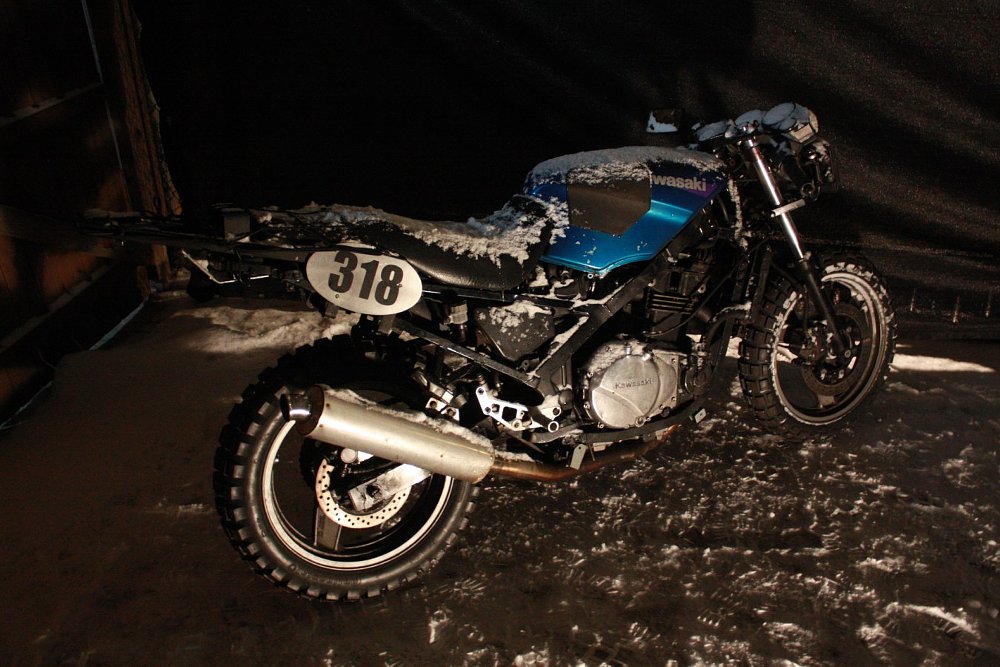
Stage four: Knobbies? Really?
I loved my Pilot Street radials, but with winter approaching, I wanted to be able to do dumb things like ride in the snow. A set of Continential TKC80s seemed like the ticket, but I was uncertain if they would actually fit. The result: sort of. I had a little bit of rub between the chain and rear tire, but I figured the epic battle of rubber versus steel would eventually work itself out by shaving the tire down into an interference-free install.
My first riding impression was a-la Michael Bloom, “I’ve made a huge mistake.” The tires squirmed as I cautiously entered my favorite turns. The bike felt, sounded and rode like a Jeep on pavement. But it did get me to and from work in the snow.
As winter thawed, I yearned to justify my knobby tire purchase with some legitimate off-roading. I told myself that I would do one solid day in the woods and I would then throw my street tires back on. One trip to the New Jersey Pine Barrens, however, changed my whole outlook on riding.
I grew up riding bicycles off-road but had abstained from enjoying the same thrill on a motorcycle. Traction was covered by my TKC80s, but my aggressive clip-ons and rearsets had to go. I needed some Pro Tapers.
The top triple tree has two M8 threaded features per side for securing the OEM risers. I sketched up a design, formalized it in Solidworks and made a quick prototype out of MDF to verify my angles before breaking out the 6061 aluminum to make my new risers.

After many trips to the Pine Barrens, I wanted to experience the off-road equivalent of a track day. I signed up for The Hammer Run, an AMA enduro event in South Jersey. I felt a little of the Burt Munro spirit as I rode into a parking lot filled with giant pickup trucks, tour rigs and even more spectacular KTMs and Huskys. I was, however, setting the world’s slowest pace. I later learned there was money on whether I would make it past the lunch checkpoint.
I almost died in the first three miles of the course, falling victim to getting progressively more and more off balance through a section of whoops. I finished in time to get some of the last grilled leftovers. The course was 86 miles off-road, and I did most of it, except for a particular section I was strongly encouraged not to do, based on my lack of ground clearance. It seemed like a reasonable course of action, given the fact that a stump in the preceding section had already ripped the muffler off and I was surrounded by the sweep crew shaking their heads at me. Plus, I still needed to ride back to Philly after all was said and done.

What’s next?
Life should get easier for my dog-hauling, snow-commuting, track-day strafing, enduro-enduring Ninja 500. I picked up a Suzuki DR350 for riding off-road and I now have a Suzuki SV650 for commuting and riding on the track. The Ninja is a blank canvas again.
I’m open to ideas.





